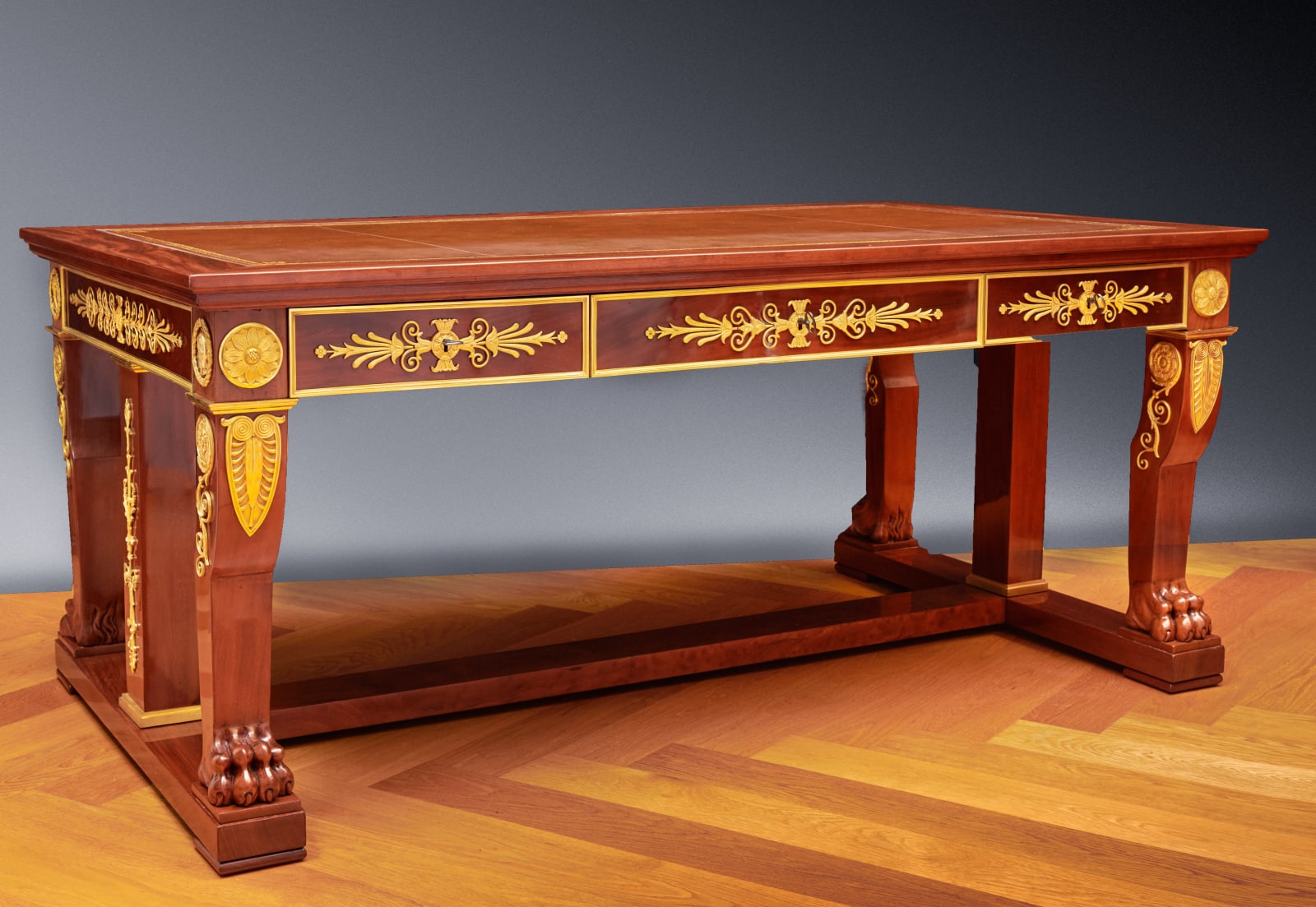Jacob-Desmalter et Cie (attributed to)
Provenance
Literature
Serge Grandjean, “Empire Furniture”, 1966, pl. 73.
Denise Ledoux-Lebard, “Le Mobilier Français du XIXe Siècle”, colour pl. XXI, illustrating a comparable bureau by Jacob-Desmalter at Palais de Compiègne.
An important and large Empire gilt bronze mounted mahogany bureau plat, attributed to Jacob-Desmalter, the rectangular top with a gilt tooled brown leather working surface above three frieze drawers each with elaborate scroll and palmetted escutcheons and flanked at the corners by rosette mounts above four massive legs with palmette and rosette mounts to the outer and inner bowed upper parts on carved lion paw feet, with angular supports between the legs and like them on an interconnecting H-shaped stretcher
Paris, date circa 1810
Height 73 cm, width 170 cm, width 100 cm.
The overall quality, use of mahogany ornamented with the finest gilt bronze mounts as well as the proportion and form of this impressive bureau plat compares closely with a grand bureau mécanique made by the eminent firm of ébénistes Jacob-Desmalter for Napoleon Bonaparte. It was supplied in 1811, for his private apartments at Palais de Fontainebleau at a cost of 6,500 francs. It differs from the present bureau in certain aspects, notably in the gilt bronze mounts on the frieze and in its mechanical construction. However as here, it has corner rosettes above the same palmettes on the bow shaped legs which likewise have lion paw feet. Furthermore, the four legs, raised on an H-shaped stretcher, have two further supports between each of the pairs. Another comparable bureau by Jacob-Desmalter was delivered in 1808 to the Emperor’s library at Palais de Compiègne, which again has a mechanical devise and is slightly simpler than here in that there are no additional supports between the legs and neither do they have lion paw feet. However its proportions are comparable; the legs are of the same form and likewise, they are headed by rosette mounts and furthermore are on an H-shaped stretcher.
The renowned firm of Parisian ébénistes Jacob Desmalter et Cie was one of the finest among the annals of French furniture making. From 1803-1813 the business was run by Georges Jacob (1739-1814) and his son François-Honoré-Georges Jacob (1770-1841) but its history, under different names, spanned over eighty years, during which they made superb quality pieces. Georges Jacob, who supplied furniture to the Garde-Meuble de la Couronne during the latter part of the eighteenth century counted among his clients the comte de Provence and the comte d'Artois, while his commissions for Queen Marie Antoinette included furnishings for the Petit Trianon and the chateaux des Fontainebleau, Versailles, St. Cloud and Rambouillet. Georges Jacob’s friendship with the Republican painter Jacques-Louis David enabled him to weather the French Revolution. In 1796 he handed the business over to his two sons Georges II (1768-1803) and François-Honoré-Georges Jacob, who worked under the name of Jacob Frères. Following Georges II's early death his younger brother went back into business with his father, adding Desmalter to his surname and renaming the business Jacob-Desmalter et Cie.
Following the coronation of Napoleon as Emperor, Jacob-Desmalter continued to be the main supplier of furnishings to the Imperial Garde-Meuble, when they made superb pieces for the Grand Trianon, Saint Cloud, Rambouillet, the Tuileries in addition to the Palais de Fontainebleau and Compiègne. In 1810 Jacob-Desmalter refurbished many of the Imperial apartments for Empress Marie-Louise upon her marriage to Napoleon that year. According to Denise Ledoux-Lebard, during the years spanning 1803-1813, the cost of furnishings provided by the firm for the Tuileries Palace alone amounted to 541,765 francs.
